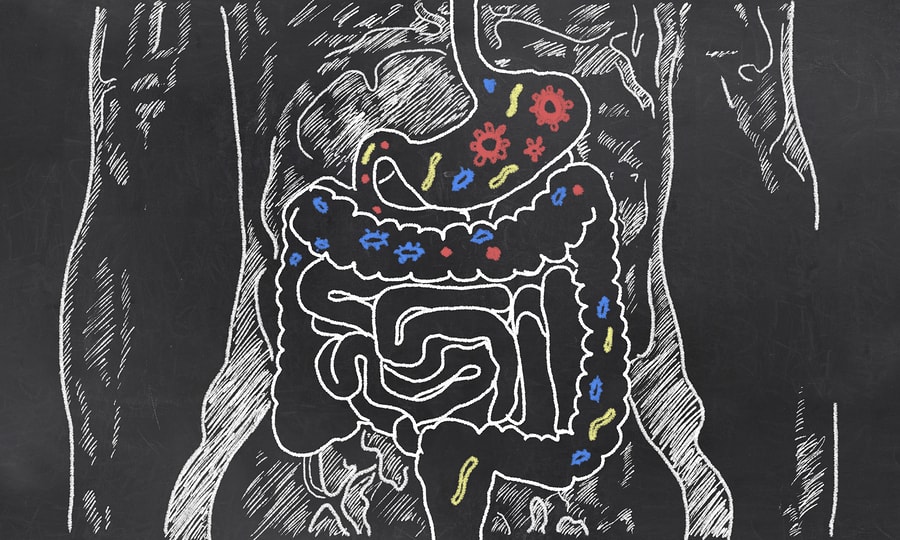
Lipopolysaccharides or LPS are bacterial toxins that can cause inflammation and health issues if they reach the bloodstream. Normally housed safely in the gut, lipopolysaccharides become toxic by entering the blood if you have an infection, “leaky gut”, or eat too many fatty foods.
Read on to learn how lipopolysaccharides cause inflammation and how you can test for them.
What Are LPS?
Definition
Lipopolysaccharides (LPS) are one of the main causes of systemic, low-grade inflammation. In fact, intravenous LPS is often used in research experiments to cause inflammation [1].
Exposure to LPS causes both rodents and people to display “sickness behavior,” including depression, impaired cognitive function, and social withdrawal [1].
LPS are also considered a key link between Western diets, inflammation, and obesity and metabolic disorders [2].
LPS are normally present in the blood at very low levels. In certain infections, LPS levels increase substantially, causing sepsis. LPS can also enter the blood during leaky gut or with certain types of fat [3].
Where Are They Found?
LPS are found on the outer membrane of Gram-negative bacteria. Gram-negative bacteria, such as E. coli and Salmonella, are a type of bacteria that often cause health problems and resist antibiotics (many probiotics, on the other hand, are gram-positive bacteria).
Gram-negative bacteria colonize the respiratory, urinary, and GI tracts, including the mouth and gut. The largest concentrations are found in the gut.
Structure
LPS are large molecules that are composed of three distinct sections [4]:
- O-antigen or O-specific chain (chain of many simple sugars, capable of being recognized by the immune system)
- Core oligosaccharide (a small chain of simple sugars)
- Lipid A (two glucosamine molecules bound to many fatty acids)
The fat component of LPS, called lipid A, is responsible for the toxic and inflammatory properties of LPS.
Lipid A is anchored to the cell membrane, while the rest of the LPS projects from the cell surface into the surrounding environment. However, once the bacteria dies, and the cell membrane falls apart, the lipid A is exposed and can cause damage [4].
How They Disrupt the Immune System
LPS are potent stimulators of the immune system. If LPS remain in the gut, they don’t activate the immune system and cause harm. The ability of LPS to promote inflammation depends on their ability to enter the blood [5].
Besides infection, the two main ways LPS can enter the blood from the gut are “leaky gut” (increased intestinal permeability) and through fat-containing chylomicrons.
Chylomicrons are fat transporters responsible for the absorption and transfer of dietary fat and cholesterol from the gut to the blood. LPS bind to chylomicrons and can be carried through the gut wall into the blood [6].
Binding and transport of LPS by chylomicrons is a natural process that helps remove LPS and take them to the liver for detoxification. However, not all of the LPS transported by chylomicrons get detoxified quickly, and some can remain unbound in the blood [6].
In the blood, LPS bind to monocytes, dendrites, macrophages and B cells (these are all white blood cells), and direct them to produce transcription factors NF-κB and AP-1.
These transcription factors then stimulate the production of inflammatory cytokines TNF-a, IL-1b, IL-6, and CRP. LPS can also increase the production of nitric oxide, superoxide (a free radical), and eicosanoids (products of fat breakdown that increase inflammation, such as PGE2) [5].
Detoxing LPS
The liver is the main organ responsible for LPS clearance from the blood. Most systemic LPS are taken up by Kupffer cells in the liver, where they are neutralized and then excreted in the bile [7].
An enzyme in the gut called alkaline phosphatase can remove phosphate groups from LPS, which reduces their inflammatory effects. If enzyme levels are low, fewer LPS are broken down and circulating LPS levels are increased [8].
Causes of Elevated Blood LPS Levels
1) Infection
The condition of elevated LPS in the blood (endotoxemia) occurs most severely during infection when large amounts of gram-negative bacteria enter the blood.
Hospitals measure their patients’ LPS levels to predict survival after an infection or procedure [9].
An example of an infection causing endotoxemia is periodontitis, where high levels of LPS from the mouth enter the blood and cause systemic inflammation [10].
Another common infection causing endotoxemia is Neisseria meningitidis, which can spread from the back of the nose and throat to elevate LPS levels throughout the body. This leads to meningococcal diseases such as inflammation of the membranes (meninges) surrounding the brain and spinal cord, or meningitis [11].
2) “Leaky Gut”
LPS are large molecules and are too big to pass through the tiny gaps in the gut of a healthy person. However, when the gut lining becomes damaged and bigger gaps arise, LPS can pass through this “leaky gut” into the blood.
In a study of 44 patients undergoing pancreas surgery, systemic LPS levels correlated with “leaky gut” in an almost perfectly linear relationship [12].
“Leaky gut” was associated with LPS in 137 individuals [13, 14].
However, another study found that “leaky gut” caused by aspirin did not lead to increased LPS levels in the blood [15].
In mice, “leaky gut” causes increased LPS and systemic inflammation [16].
3) High-Fat Meals
In a study of 20 participants, consumption of two meals with an equivalent amount of calories (one with high fat, one with low fat) showed that the higher-fat meal increased LPS, reactive oxygen species, and NF-κB activity [17].
In a study of 12 men, eating a mixed breakfast with 33% calories from fat increased LPS and the inflammatory cytokine IL-6 2 hours after the meal [18].
Increased levels of LPS in blood and chylomicrons were found 3 hours after consumption of 50 g fat (10 g saturated fat, 30 g monounsaturated fat, and 10 g polyunsaturated fat) in a study of 40 obese patients [19].
Short- and medium-chain fatty acids do not elevate LPS levels because they are absorbed directly by the portal vein and do not cause chylomicron formation [20, 6].
A person’s body fat may affect how their LPS levels respond to fat. In a study of 16 men, only obese individuals had higher post-meal LPS levels after 40 g of dairy fat compared to normal-weight people. The chylomicrons of obese people were more saturated with LPS than those of normal-weight people as well [21].
Similarly, in a study of 54 people, those with type 2 diabetes, impaired fasting glucose, and obesity had elevated LPS levels in response to a high-fat meal, while lean, healthy people did not. LPS levels increased by 124% in type 2 diabetes patients [22].
Saturated Fat
In a clinical trial of 75 metabolic syndrome patients, a high saturated fat diet increased LPS levels compared to a high monounsaturated fat diet, a low-fat, complex carb diet, and a low-fat, complex carb diet supplemented with omega-3s [23].
In a study of 8 adults, a one-month high-fat (40% of total calories) and saturated fat (20% of total calories) diet increased LPS levels by 71%, compared to a low-fat, high-fiber diet in which LPS levels dropped by 31% [24].
In a study of 48 healthy people, 300 calories of pure cream increased LPS levels up to 5 hours after consumption, while equal calories of sugar, orange juice, and water did not [25].
In a study of 20 healthy adults, 16 g of coconut oil (82% saturated fat) increased LPS, but omega 3 consumption resulted in a lower LPS response. There was no LPS increase from grapeseed oil (omega-6 fatty acid) [26].
In a study of 28 people, 3 weeks of a diet high in the saturated fat palmitic acid increased blood TNF-a levels induced by LPS. However, consumption of a high-oleic acid (monounsaturated fat) diet for 3 weeks lowered LPS-induced IL-1b, IL-18, IL-10, and TNF-a [27].
Consumption of a diet with a high palmitic acid/oleic acid ratio led to secretion of IL-1b from LPS-stimulated white blood cells (lymphocytes and monocytes) in a small trial on 12 women [28].
Emulsified Fat
Emulsified fat has had a compound (such as lecithin) added to it in order to mix more easily with water. Emulsifiers are common in many foods, including mayonnaise and ice cream. Emulsification also increases the ability of dietary fats to break down in the digestive system.
In a clinical trial on 16 men, consuming 40 g of emulsified milk fat increased levels of LPS bound to chylomicrons, compared to consuming 40 g of non-emulsified milk fat [29].
In animals, consumption of emulsified sunflower oil elevated post-meal LPS levels more than non-emulsified sunflower oil. Emulsification increases the surface area of oil and facilitates fat absorption and storage into chylomicrons [18].
4) High-Calorie Diets
Overfeeding by 760 calories/day for 8 weeks increased LPS levels by 160% in a study of 18 healthy men. LPS was associated with IL-6 [30].
Total caloric intake was associated with LPS levels in a study on almost 3,500 healthy men [31, 32].
5) Excessive Alcohol Intake
Acute binge drinking and chronic alcohol intake increase systemic LPS levels [33, 34].
Increased intestinal permeability (“leaky gut”) and higher circulating LPS levels were observed in a study of 54 patients with chronic alcohol abuse [35].
However, compared to nondrinkers, moderate alcohol consumption was associated with lower LPS levels in a study of over 900 adults [36].
6) Gut Dysbiosis
Gut dysbiosis is an imbalance of gut bacteria, where normally dominant species are reduced and/or normally reduced species are increased (such as small intestinal bacterial overgrowth, or SIBO).
In a study of 30 healthy adults, those with lower fecal bacteroidetes levels had increased blood LPS [37].
In mice, probiotic bifidobacteria can reduce LPS levels by improving gut barrier function. In contrast, increasing the proportion of gram-negative bacteria can increase intestinal permeability and lead to higher blood LPS levels [2].
7) Stress
In a clinical trial on 39 women, those who completed a stressful task in the presence of a critical audience had greater LPS-stimulated production of TNF-a than those who performed the task without an audience [38].
In another trial on 72 women, delivering a mock job interview followed by a difficult puzzle-solving task increased LPS-stimulated production of TNF-a and IL-6 [39].
8) Social Isolation
In a study of 115 participants, individuals more sensitive to social disconnection showed increased inflammatory molecules (TNF-a and interleukin-6) in response to LPS and increased activity of multiple inflammatory genes [40].
In two studies, people who had more feelings of loneliness had greater LPS-stimulated production of TNF-a, IL-6, and IL-1 in response to a stressful task compared to those who were less lonely [41, 42].
9) Stressful Childhood
Exposure to an unpredictable and stressful childhood environment was related to greater LPS-stimulated IL-6 production in a study of 135 adolescent girls [43].
10) Smoking
A single smoked cigarette contains high levels of biologically-active LPS due to the bacteria on the tobacco leaves [44].
Cigarette smoking increased the production of an LPS-stimulated protein (TLR4) and LPS-related inflammatory cytokines (NF-κB, IL-8) in human airway cells [45].
How to Measure LPS
Lab results are commonly shown as a set of values known as a “reference range”, which is sometimes referred to as a “normal range”. A reference range includes the upper and lower limits of a lab test based on a group of otherwise healthy people.
Your healthcare provider will compare your LPS test results with reference values to see if they fall outside the range of expected values. By doing so, you and your healthcare provider can gain clues to help identify possible conditions or diseases.
Remember that some lab-to-lab variability occurs due to differences in equipment, techniques, and chemicals used. Don’t panic if your result is slightly out of range in the app – as long as it’s in the normal range based on the laboratory that did the testing, your value is normal.
However, it’s important to remember that a normal test doesn’t mean a particular medical condition is absent. Your doctor will interpret your results in conjunction with your medical history and other test results.
But remember that a single test isn’t enough to make a diagnosis. Your doctor will interpret this test, taking into account your medical history and other tests. A result that is slightly low/high may not be of medical significance, as this test often varies from day to day and from person to person.
Blood LBP Test
The best measurement of LPS is blood LPS-binding protein (LBP). Although direct measurement of LPS is possible, LBP is generally considered a more reliable, accurate, and better biomarker of total bacterial load [46].
Produced mainly in the liver, LBP binds to LPS and amplifies immune responses. Thus, LBP is a biomarker of both LPS load and the associated innate immune response [47].
Circulating LBP is associated with increased body weight, decreased insulin sensitivity, type 2 diabetes, and obesity [48, 49].
Dietary modification of gut bacteria due to lifelong calorie restriction reduced LPB in mice [50].
Normal Levels
In patients with a bacterial infection, LBP levels were 33.41 mg/L, compared to 5.61 mg/L in healthy patients [51].
In healthy, normal-weight adolescents, LBP levels were 6 mg/L, compared to 7.8 mg/L in overweight and obese youth [52].
Learn More
Takeaway
Lipopolysaccharides (LPS) are bacterial toxins that may enter the blood if you have an infection or “leaky gut.” Limited research shows that these small, foreign particles can cause low-grade inflammation, depression, obesity, and cognitive problems.
LPS is found in many bacteria that cause gut, respiratory, and urinary infections. “Good” gut bacteria and probiotics don’t contain LPS.
Two common causes of LPS and inflammation are infections and “leaky gut.” Many unhealthy habits–such as smoking, heavy drinking, stress, and gut imbalances from a poor diet–can also raise LPS in the body.
LPS levels can be measured in the blood. Your doctor may order this test if they suspect you have a bacterial infection.



